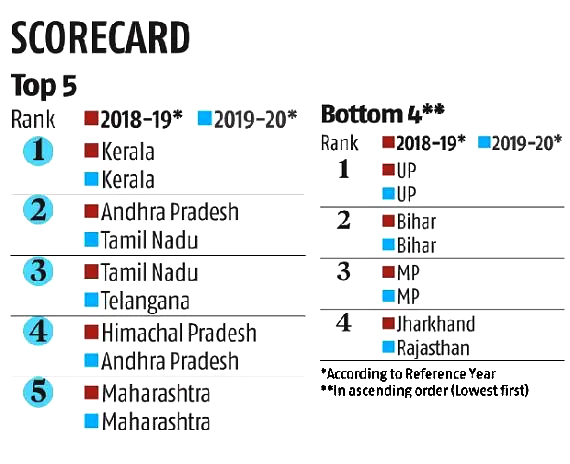Social Justice
Fourth Edition of State Health Index
- 28 Dec 2021
- 6 min read
For Prelims: About the Index, Ranking of States.
For Mains: Challenges of the Health Sector in India and Initiatives taken to address it
Why in News
NITI Aayog has released the fourth edition of the State Health Index for 2019–20.
- The report, titled “Healthy States, Progressive India”, ranks states and Union Territories on their year-on-year incremental performance in health outcomes as well as their overall status.
- Earlier, the Global Health Security (GHS) Index 2021, developed in partnership by the Nuclear Threat Initiative (NTI) and the Johns Hopkins Center was released. India, with a score of 42.8 (out of 100) has slipped by 0.8 points since 2019.
Key Points
- About:
- The State Health Index is an annual tool to assess the performance of states and UTs, which has been compiled and published since 2017.
- It is a weighted composite index based on 24 indicators grouped under the domains of ‘Health Outcomes’, ‘Governance and Information’, and ‘Key Inputs/Processes’.
- Health Outcomes:
- It includes parameters such as neonatal mortality rate, under-5 mortality rate, sex ratio at birth.
- Governance and Information:
- It includes parameters such as institutional deliveries, average occupancy of senior officers in key posts earmarked for health.
- Key Inputs/Processes:
- It consists of proportion of shortfall in health care providers to what is recommended, functional medical facilities, birth and death registration and tuberculosis treatment success rate.
- Health Outcomes:
- Developed By:
- NITI Aayog, with technical assistance from the World Bank, and in close consultation with the Ministry of Health and Family Welfare (MoHFW).
- Focus of the Fourth Edition:
- Round IV of the report focuses on measuring and highlighting the overall performance and incremental improvement of states and UTs over the period 2018–19 to 2019–20.
- Ranking of States:
- To ensure comparison among similar entities, the ranking is categorized as:
- Larger States:
- In terms of annual incremental performance, Uttar Pradesh, Assam and Telangana are the top three ranking states.
- Smaller States:
- Mizoram and Meghalaya registered the maximum annual incremental progress.
- Union Territories:
- Delhi, followed by Jammu and Kashmir, showed the best incremental performance.
- Overall:
- The top-ranking states were Kerala and Tamil Nadu among the ‘Larger States’, Mizoram and Tripura among the ‘Smaller States’, and Dadra and Nagar Haveli and Daman and Diu (DH&DD) and Chandigarh among the UTs.
- Larger States:
- To ensure comparison among similar entities, the ranking is categorized as:
- Significance of the Index:
- Policymaking:
- States use it in their policy making and resource allocation.
- This report is an example of both competitive and cooperative federalism.
- States use it in their policy making and resource allocation.
- Healthy Competition:
- The index encourages healthy competition and cross-learning among States and UTs.
- The aim is to nudge states/UTs towards building robust health systems and improving service delivery.
- Helpful in Achieving SDGs:
- The exercise is expected to help drive state and union territories' efforts towards the achievement of health-related Sustainable Development Goals (SDGs) including those related to Universal Health Coverage (UHC) and other health outcomes.
- Role in National Health Mission:
- The importance of this annual tool is reemphasized by MoHFW’s decision to link the index to incentives under the National Health Mission.
- Policymaking:
- Limitations of the Index:
- Not Covered Critical Areas:
- Some critical areas such as infectious diseases, noncommunicable diseases (NCDs), mental health, governance, and financial risk protection are not fully captured in the Health Index due to non-availability of acceptable quality of data on an annual basis.
- Limited Data:
- For several indicators, the data is limited to service delivery in public facilities due to paucity and uneven availability of private sector data on health services.
- For outcome indicators, such as Neonatal Mortality Rate, Under-five Mortality Rate, Maternal Mortality Ratio and Sex Ratio at Birth, data are available only for Larger States.
- For several indicators, the data is limited to service delivery in public facilities due to paucity and uneven availability of private sector data on health services.
- Without any Field Verification:
- For several indicators, Health Management Information System (HMIS) data and programme data were used without any field verification due to the lack of feasibility of conducting independent field surveys.
- Not Covered Critical Areas:
Related Initiatives







